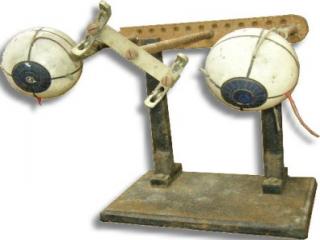器材原始說明資料: Ophthalmotrope (Model of the muscles of the eye) , 動眼筋模型
E.ZIMMERMANN LEIPZIG-BERLIN (1928-1945) Nr.2
Ophthalmotrope ( Harvard Collection )
Experimental psychology : a manual of laboratory practice / Titchener Edward Bradford, New York ; London : Macmillan (1901)
Handbuch der physiologischen Optik / Helmholtz, Hermann von, Leipzig : Leopold Voss (1867)
Grundzüge der physiologischen Psychologie / Wundt Wilhelm Max , Leipzig : Engelmann (1893)
Wade N J, Sakurai K, Gyoba J, 2007, "Whither Wundt?" Perception 36(2) 163 – 166
A technical eye inspired by biology -- Brandt 129 (4): 1070 -- Brain (2006)
The moving tablet of the eye: the origins of modern eye movement research / Nicholas Wade, Benjamin, W. Tatler Oxford University Press, 2005
Special catalogue of the collective exhibition of scientific instruments and appliances exhibited by the Deutsche gesellschaft für mechanik und optik, Berlin (1893)
" Helmholtz used ophthalmotrope (above) in 19th-century study of vision. Descartes offered a 16th-century explanation of the eye (see below):... "
Are We Finding a Way to Study the Action of the Mind: Annual Meeting, 26-31 December, Berkeley Science, New Series, Vol. 150, No. 3698 (Nov. 12, 1965), pp. 922-924
 Ophthalmotrope. An excellent device for making clear the action of the extrinsic muscles of the eye. The cords of different colors, representing the muscles, run over pulleys and are kept taut by weights. The eye models are mounted on ball-and-socket joints and so are easily adjustable. The right eye is furnished with a rod, at the end of which is attached a disk indicating the field of view. A special upright with a pulley and counterpoise permits easy adjustment of the disk representing the field of view.
Ophthalmotrope. An excellent device for making clear the action of the extrinsic muscles of the eye. The cords of different colors, representing the muscles, run over pulleys and are kept taut by weights. The eye models are mounted on ball-and-socket joints and so are easily adjustable. The right eye is furnished with a rod, at the end of which is attached a disk indicating the field of view. A special upright with a pulley and counterpoise permits easy adjustment of the disk representing the field of view. |

|
|